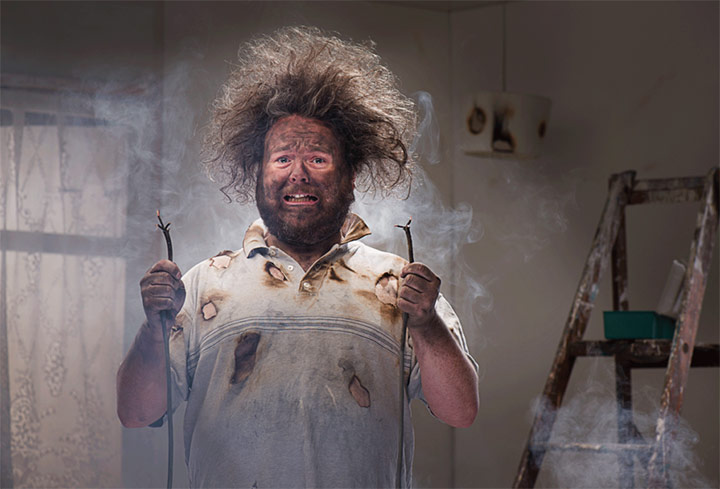There’s no better time than spring to take care of necessary home projects. While certain projects such as fixing a leaky faucet or painting a room can easily be done on your own, jobs involving plumbing, electrical or HVAC repairs must be left up to the professionals. Otherwise, these projects could result in bodily injury, complicated home resales, voided warranties, insurance claims or even legal consequences. That’s why we at Ballard in San Bernardino are here to guide you. Here are 10 house projects you don’t want to DIY.
1. Switching from an electric range to a gas stove
This swap is not as easy as one might think. Switching from an electric range to a gas stove requires two sets of up-to-date codes, which is why you’ll need the help of both an electrician and a plumber. When not connected properly, the gas line can form leaks, causing dangerous emissions, high levels of which can be fatal. Additionally, shoddy electrical wiring can easily result in fires. In attempting to sell your house, if this electrical wiring is not deemed up to code by an inspector, you will have to pay a fine and hire someone to fix it. Avoid these issues by reaching out to trusted professionals.
2. Replacing a water heater tank
Water heater tank installation requires permits, code checks and specific safety regulations, necessitating the help of a professional. A DIY replacement gone wrong could result in harmful carbon monoxide emissions within your home. This toxic gas is odorless and tasteless, making it undetectable. With such a project, you would also be working with gas lines and high-voltage electricity. One error could result in an explosive leak. For these reasons, this project requires a professional.
3. Major electrical repairs
Avoid doing major electrical repairs by yourself. Replacing, adding or tinkering with light fixtures affects electrical wiring and is best left up to the expertise of an electrician. Without an adequate level of care, you’re likely to electrocute yourself or even spark a fire. Additionally, faulty wiring is the leading cause of residential fires, and without proper permits showing installation by a professional, insurance companies have grounds to deny your insurance claims in the case of a house fire. It’s best to call your local electrician for this task.
3. Removal and replacement of old installation
While replacing insulation is not a difficult task, within older homes, this project does require the special attention of a professional. Insulation in older homes has a higher chance of containing toxins such as asbestos, a known carcinogen. When inhaled, the fibers within asbestos have the potential to cause cancerous diseases later on. Hire an asbestos abatement team to remove the old, contaminated insulation, as they know how to safely complete the project without introducing hazards into your home.
4. Pumping the septic system
While pumping the septic system is fourth on our list, it can be easily ranked as the most unpleasant chore. It also requires specialized equipment and permits in order to dispose of the waste properly. The only step of this project you need to worry about is calling a professional.
5. Major renovations
Major home improvements such as installing a skylight or knocking out a wall should be done by a professional. A DIY attempt of these huge projects could result in major damage to the integrity of your home. For instance, skylights not only require cutting a hole in your ceiling, but also installing a frame and fitting a window into the roof. Not to mention, one wrong swing when knocking out a wall could result in structural damage to your home. Avoid these hassles, and have a qualified specialist take care of the job for you.
6. Getting rid of lead-based paint
Removing lead-based paint from older homes can be a nightmare. It’s a deadly material that exists within approximately 75% of all homes built before 1978. Due to its severe health risks, you should never attempt to remove lead-based paint by yourself. Instead, call an experienced professional to handle the job.
7. Taking out termites
Termite problems are expensive, costing property owners $5 billion each year. A termite infestation cannot be fixed with DIY solutions or store-bought products. Tackle this issue fast by reaching out to your local exterminator, as they have access to the most potent products to restore your home and your peace of mind.
8. Interacting with wildlife
If a critter has made a home for itself in your rafters, it’s time to call a in professional. Rodents such as bats, raccoons and skunks can carry rabies, meaning a DIY critter-removal may put you at risk for infection. Additionally, you could face legal repercussions should these animals be harmed or trapped and relocated without the help of a trained professional. Not only will a professional take care of the removal for you, but they will also secure any openings created in your rafters, clean out nests and take care of any waste.
9. Cutting down large trees
Removing large trees is no small task. Not only does this job require special equipment, but it must also be done in compliance with city ordinances. Hire a professional (better yet: a certified) arborist who is familiar with these ordinances, carries liability insurance and knows how to handle potential accidents or hazards.
10. Repairing your HVAC system
While it may be tempting to repair or replace an HVAC system by yourself, there are several health and safety risk factors involved. Additionally, manufacturers have the right to void your system’s warranty should work be done without proper licensing. Therefore, call upon the expertise of a licensed professional to repair or replace your system. This will ultimately save you time, money, and stress in the long run.
Don’t go through with major home improvements alone! Call Ballard at 909-297-1914 or reach out online to schedule HVAC system service today. We’ll spring into action, improving your home while keeping you and your family safe.

